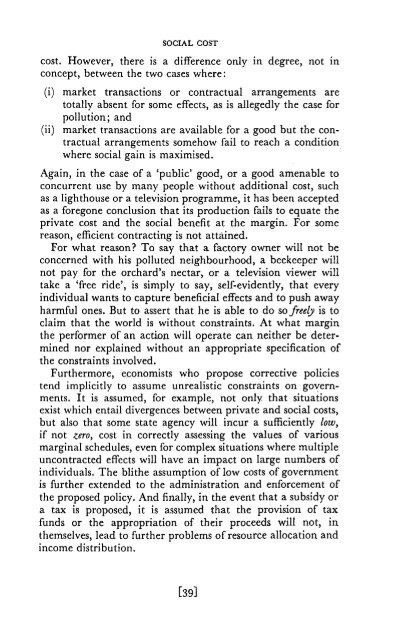THE MYTH OF SOCIAL COST.pdf - Institute of Economic Affairs
THE MYTH OF SOCIAL COST.pdf - Institute of Economic Affairs
THE MYTH OF SOCIAL COST.pdf - Institute of Economic Affairs
You also want an ePaper? Increase the reach of your titles
YUMPU automatically turns print PDFs into web optimized ePapers that Google loves.
<strong>SOCIAL</strong> <strong>COST</strong><br />
cost. However, there is a difference only in degree, not in<br />
concept, between the two cases where:<br />
(i) market transactions or contractual arrangements are<br />
totally absent for some effects, as is allegedly the case for<br />
pollution; and<br />
(ii) market transactions are available for a good but the contractual<br />
arrangements somehow fail to reach a condition<br />
where social gain is maximised.<br />
Again, in the case <strong>of</strong> a 'public' good, or a good amenable to<br />
concurrent use by many people without additional cost, such<br />
as a lighthouse or a television programme, it has been accepted<br />
as a foregone conclusion that its production fails to equate the<br />
private cost and the social benefit at the margin. For some<br />
reason, efficient contracting is not attained.<br />
For what reason? To say that a factory owner will not be<br />
concerned with his polluted neighbourhood, a beekeeper will<br />
not pay for the orchard's nectar, or a television viewer will<br />
take a 'free ride', is simply to say, self-evidently, that every<br />
individual wants to capture beneficial effects and to push away<br />
harmful ones. But to assert that he is able to do so freely is to<br />
claim that the world is without constraints. At what margin<br />
the performer <strong>of</strong> an action will operate can neither be determined<br />
nor explained without an appropriate specification <strong>of</strong><br />
the constraints involved.<br />
Furthermore, economists who propose corrective policies<br />
tend implicitly to assume unrealistic constraints on governments.<br />
It is assumed, for example, not only that situations<br />
exist which entail divergences between private and social costs,<br />
but also that some state agency will incur a sufficiently low,<br />
if not zero, cost in correctly assessing the values <strong>of</strong> various<br />
marginal schedules, even for complex situations where multiple<br />
uncontracted effects will have an impact on large numbers <strong>of</strong><br />
individuals. The blithe assumption <strong>of</strong> low costs <strong>of</strong> government<br />
is further extended to the administration and enforcement <strong>of</strong><br />
the proposed policy. And finally, in the event that a subsidy or<br />
a tax is proposed, it is assumed that the provision <strong>of</strong> tax<br />
funds or the appropriation <strong>of</strong> their proceeds will not, in<br />
themselves, lead to further problems <strong>of</strong> resource allocation and<br />
income distribution.<br />
[39]












